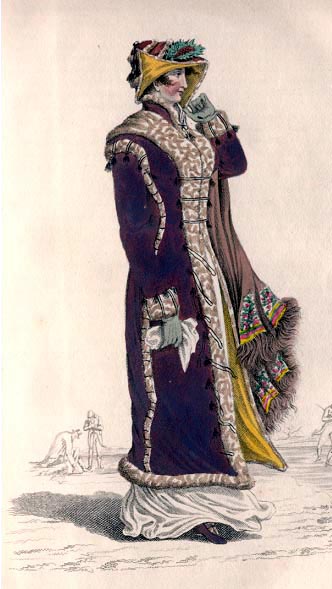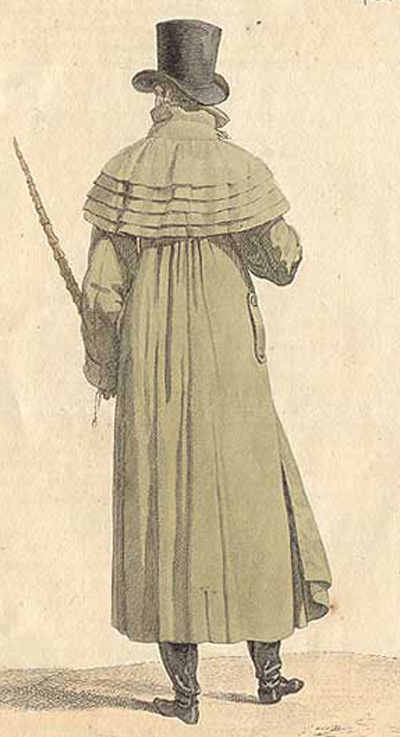 One of the reasons so many of us love the Regency is the elegance of the clothing: the simplicity, the reliance on truly beautiful lines and well-chosen details rather than fussiness and tight corseting. But among the many beautiful creations of the time there were also some fashion horrors, especially near the end of the period with the advent of Victorian excess.
One of the reasons so many of us love the Regency is the elegance of the clothing: the simplicity, the reliance on truly beautiful lines and well-chosen details rather than fussiness and tight corseting. But among the many beautiful creations of the time there were also some fashion horrors, especially near the end of the period with the advent of Victorian excess.
So here’s my take on the Best and Worst of Regency fashion.
Best #1: from a painting by Constance Mayer (left), 1801, possibly a self-portrait. This is everything I love about Regency style: simple, elegant with just a touch of decoration around the sleeves and a ribbon threaded through the hair. Forever chic.
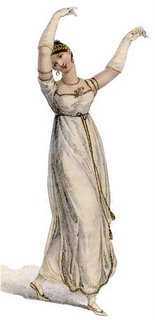 Best #2: a dress for dancing, circa 1809 (right). With the same elegant lines plus simple gold embellishments, it’s the perfect thing to wear to Almack’s and attract the attention of an eligible lord. (No wonder the Republic of Pemberley chose to incorporate this image into its coat of arms.)
Best #2: a dress for dancing, circa 1809 (right). With the same elegant lines plus simple gold embellishments, it’s the perfect thing to wear to Almack’s and attract the attention of an eligible lord. (No wonder the Republic of Pemberley chose to incorporate this image into its coat of arms.)
 Best #3: Portrait of a lady by Henri François Mulard, ca. 1810 (left). She just looks so pretty, with her simple white dress, nice touches of blue in the sash and fichu, contrasting color in the coral jewelry and the shawl. And her hair is so pretty, too!
Best #3: Portrait of a lady by Henri François Mulard, ca. 1810 (left). She just looks so pretty, with her simple white dress, nice touches of blue in the sash and fichu, contrasting color in the coral jewelry and the shawl. And her hair is so pretty, too!
 Best #4: Walking dress, La Belle Assemblée, 1813 (right). Pretty and white, again with nicely coordinated touches of blue and the gold of the straw bonnet. What a cute little sash at the back, and such dainty footwear. One never knows whom one might meet when out for a stroll, after all!
Best #4: Walking dress, La Belle Assemblée, 1813 (right). Pretty and white, again with nicely coordinated touches of blue and the gold of the straw bonnet. What a cute little sash at the back, and such dainty footwear. One never knows whom one might meet when out for a stroll, after all!
 Best #5: Ingres, Mlle de Senonnes, 1815 (left). Those French women just know how to do it. Velvet in a passionate red, that naughty look-but-don’t touch gauzy neckline, and the froth of lace. The perfect ensemble in which to seduce your rakish romance hero. Tres sexy!
Best #5: Ingres, Mlle de Senonnes, 1815 (left). Those French women just know how to do it. Velvet in a passionate red, that naughty look-but-don’t touch gauzy neckline, and the froth of lace. The perfect ensemble in which to seduce your rakish romance hero. Tres sexy!
And now for the worst…
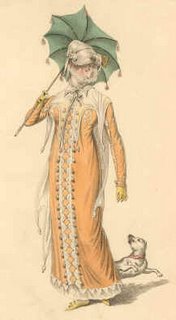 Worst #1: A walking dress from around 1810 (right). Look at all those silly tassels, the overly vertical lines, the silly lacing over the breasts. No wonder the dog is barking at her. Hope he snaps off some of those extra tassels.
Worst #1: A walking dress from around 1810 (right). Look at all those silly tassels, the overly vertical lines, the silly lacing over the breasts. No wonder the dog is barking at her. Hope he snaps off some of those extra tassels.
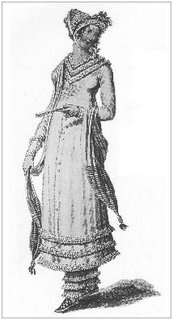 Worst #2: Bathing Place Evening Dress, 1810 (left). I don’t even know where to begin on this one. What a hideous shape, and that short skirt length, and all those silly ruffles! Makes me think of those frilly things they used to put on lamb chops. Ugh! And this is supposed to be evening wear?
Worst #2: Bathing Place Evening Dress, 1810 (left). I don’t even know where to begin on this one. What a hideous shape, and that short skirt length, and all those silly ruffles! Makes me think of those frilly things they used to put on lamb chops. Ugh! And this is supposed to be evening wear?
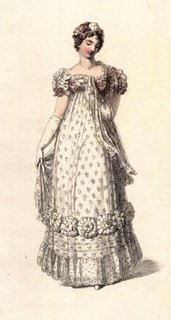 Worst #3: Evening dress, from Ackermann’s Repository, 1816 (right). Now we see a new fussiness in the rosettes, the patterns, the flounces. If you are at all short or plump, you will look like a wedding-cake in this!
Worst #3: Evening dress, from Ackermann’s Repository, 1816 (right). Now we see a new fussiness in the rosettes, the patterns, the flounces. If you are at all short or plump, you will look like a wedding-cake in this!
 Worst #4: Evening dress, 1818 (left). They put everything but the kitchen sink onto this dress: strands of pearls, the sleeves with spiral-wound ruffles of lace, all that padded satin down the front. And that turban! All proof there are always some people who are into conspicuous consumption.
Worst #4: Evening dress, 1818 (left). They put everything but the kitchen sink onto this dress: strands of pearls, the sleeves with spiral-wound ruffles of lace, all that padded satin down the front. And that turban! All proof there are always some people who are into conspicuous consumption.
 Worst #5: Court dress, modeled by Queen Caroline. How hideous is this???!!! Whoever thought that an empire waist should be combined with a hoop skirt is guilty of the most heinous Fashion Crime of the Millennium.
Worst #5: Court dress, modeled by Queen Caroline. How hideous is this???!!! Whoever thought that an empire waist should be combined with a hoop skirt is guilty of the most heinous Fashion Crime of the Millennium.
Whew!
So what does everyone else think?
Which ensemble would you like to wear? Which one deserves the honor of Best Regency Style?
Which do you think is the least becoming? The overall Worst Fashion Faux Pas of the Regency?
Elena
LADY DEARING’S MASQUERADE, RT Reviewers’ Choice Award nominee
www.elenagreene.com




